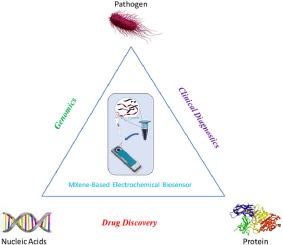Sensors and Actuators Reports Pub Date : 2023-09-13 , DOI: 10.1016/j.snr.2023.100175 Aibobek Seitak , Shaohong Luo , Ning Cai , Kin Liao , Anna-Maria Pappa , Sungmun Lee , Vincent Chan

|
MXenes, is an attractive new class of two-dimensional (2D) materials, discovered in 2011. Since then, owing to their unique combination of properties, such as high specific area, high electrical conductivity, tunable hydrophilicity, tunable chemical composition, and potential cytocompatibility, MXenes have made a deep impact on various fields ranging from electronics to energy and more recently to biotechnology. A typical example for the latter, is their use as electroactive biointerfaces in a number of biosensor setups, exhibiting remarkable analytical performance. In particular, MXene-based nanocomposites can serve as bioreceptors, electrochemical transducers or amplification probes towards translating molecular recognition of biological targets into detectable signals, leading to ultrasensitive biosensors for probing biomarkers, or pathogens. This concise review highlights the recent advances of MXene-based electrochemical biosensors for highly selective and sensitive detection of nucleic acids, proteins and pathogens pertaining to biomarker identification and clinical diagnostics. In particular, the effects of synthetic routes, surface chemistry, nanocomposite design, and fabrication methods of MXenes on the resulting relationship between biointerfacial structure, electrochemical properties and device performance is discussed, providing unique perspectives and design criteria for the next wave of biosensors.
中文翻译:

用于生物分子和病原体检测的基于 MXene 的电化学生物传感器的出现
MXenes 是 2011 年发现的一类极具吸引力的新型二维 (2D) 材料。此后,由于其独特的性能组合,例如高比表面积、高电导率、可调亲水性、可调化学成分和电势由于细胞相容性,MXene 对从电子到能源以及最近的生物技术等各个领域产生了深远的影响。后者的一个典型例子是它们在许多生物传感器设置中用作电活性生物界面,表现出卓越的分析性能。特别是,基于 MXene 的纳米复合材料可以用作生物受体、电化学传感器或放大探针,将生物靶标的分子识别转化为可检测信号,从而形成用于探测生物标志物或病原体的超灵敏生物传感器。这篇简明的综述重点介绍了基于 MXene 的电化学生物传感器的最新进展,用于高选择性和灵敏地检测与生物标志物识别和临床诊断相关的核酸、蛋白质和病原体。特别是,讨论了 MXene 的合成路线、表面化学、纳米复合材料设计和制造方法对生物界面结构、电化学性能和器件性能之间关系的影响,为下一波生物传感器提供了独特的视角和设计标准。



























 京公网安备 11010802027423号
京公网安备 11010802027423号